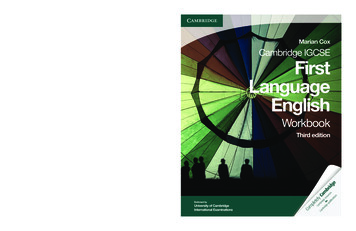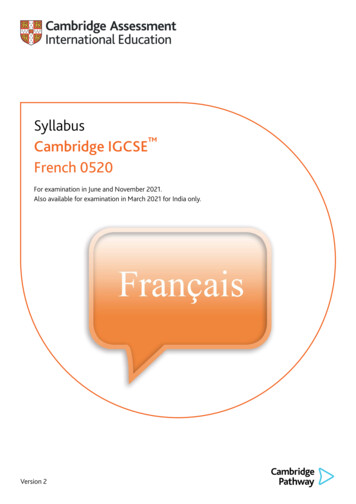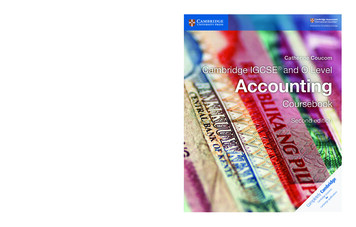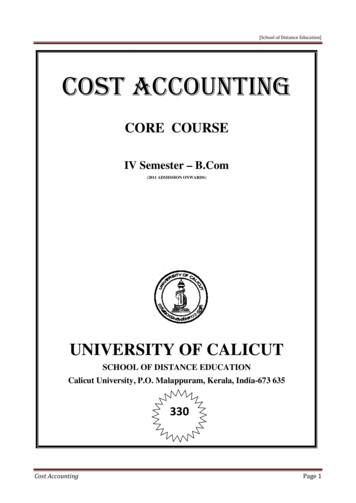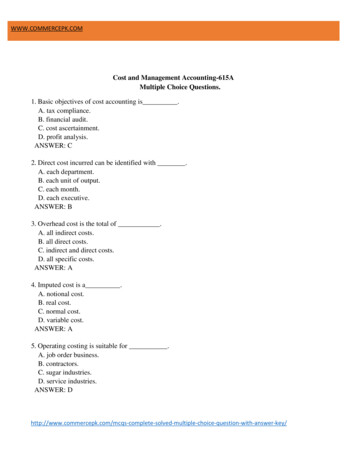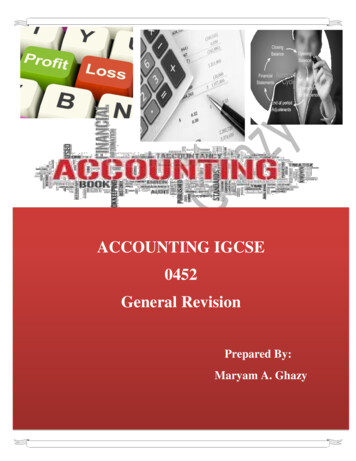
Transcription
IGCSE – Accounting 0452ACCOUNTING IGCSE0452General RevisionPrepared By:Maryam A. Ghazy1
IGCSE – Accounting 0452Definitions1- Assets & Liabilities Assets : is an item of value owned by a company Liabilities : are creditors’ claims on assets that reflect obligations to provideassets, products or services to others2- Carriage inwards & Carriage outwards. Carriage inwards: is the shipping and handling costs incurred by a company thatis receiving goods from suppliers (appear in income statement as a cost ofPurchases) Carriage outwards: is the shipping and handling costs incurred by a company thatis shipping goods to a customer. (appear in income statement as a otherexpenses )3- Accounting & Bookkeeping Accounting : is an information system – includes the process of recording,classifying, summarizing, reporting, analyzing and interpreting the financialcondition and performance of a business – in order to communicate it tostakeholders for business decision making. Bookkeeping: is the process of recording, in chronological order, the dailytransactions of a business entity. It forms part of the accounting informationsystem.4- Error of principle & Error of Commission. Error of principle : when a transaction is entered using the correct amount and onthe correct side but in the wrong account of the same class. Error of Commission: when a transaction is entered using the correct amount andon the correct side but in the wrong class2
IGCSE – Accounting 04525- Debit Note& Credit note Debit Note: A document sent to a supplier asking for allowance for unsatisfactorygood ( reduction of the amount due ) Credit Note: A document sent to a customer showing allowance given bysupplier in respect of unsatisfactory good ( reduction of the amount due )Supplier (T.P)Customer ( T.R)Debit NoteAsking for all allowanceCredit NoteAccepting the allowance6- Gross Profit & Net Profit. Gross Profit : It’s that profit achieved by the business without taking inconsideration the operating expenses as electricity and rent ( the differencebetween the selling price and the cost price )Gross profit Net Sales – Cost of Sales Net Profit : It’s the final profit that is awarded to the owner of the business at theend of each financial year after deducting all the expenses from all the revenue.Net profit Gross profit other revenue – other expenses.7- Service business & trading business Service business : do not have these inventories. Service firms derive theirrevenue from services which they provide to customers. Trading business : are businesses that buy goods which will be resold to itsbuyers. Trading firms usually have inventories of goods to be resold3
IGCSE – Accounting 04528- Current Liabilities & non- Current Liabilities Current Liabilities : represents amounts payable with in a period of 12 monthsfrom the balance sheet date as ( Bank overdraft – trade payables – owingexpenses ) Non- Current Liabilities: : There are the amounts payable more than 12 monthsafter the balance sheet date as ( Loans )9- Trade payable & Trade Receivables. Trade payable: Is the amount due to the suppliers who provide the company withits needs of inventory , goods , raw materials on credit Trade Receivables: amount owed by customers buying the company's goods oncredit.10- Capital expenditure & Revenue expenditure. Capital expenditure : Money paid to buy /install or improvement Non -Currentassets and legal fees paid to register Non –Current assets . It’s recorded at thestatement of financial position. Revenue expenditure: Money paid to run a business . It’s recorded as expenses atincome statement11- Bad debts & Provision for doubtful debts. Bad debts : Amount of money which the trade receivable won’t be able to pay(Considered as expense) Provision for doubtful debts: It’s an estimate to the amount of money thebusiness won’t be to collect from its trade receivables. ( Varies from each year)12- Bank Statement & bank Reconciliation Statement. Bank Statement : Is a copy of the business as it appears in the books of the bank. Bank Reconciliation Statement: shows the balance on the bank statementadjusted for amounts not yet credited , Cheques not yet presented and any Bankerror . the final figure should agree with the balance in the bank account in theCash book.4
IGCSE – Accounting 045213- Margin & Mark – up Margin : Is the gross profit measured as a percentage of selling price( Gross profit Sales ) 100 Mark – up: Is the gross profit measured as a percentage of cost price( Gross profit cost of sales ) 10014- Partner‟s capital account & Partner‟s Current account. Partner’s capital account : These accounts are kept to record the beginningcontribution of partners in financing the business and any change occur to. Partner’s Current account: These accounts are kept to record either the amountowed by or owed to partner for each year.15- Prime Cost & Cost of production. Prime Cost : The Total of direct labor , direct material and direct expenses Cost of production : Is founding by adding the factory overhead to the primecost.16- Called up share Capital & paid up share capital. Called up share Capital : Total amount of shares the company had requested fromshareholders paid up share capital.: part of called up capital where company had actuallyreceived from shareholders17- Preference shares & Ordinary shares.- Preference shares & Ordinary Shares are a Shares in a company ( equityshares) but the Preference shares give their holders an entitlement to a fixeddividend but which do not usually carry voting rights. The importantdifference between preference and ordinary shares are:1.The dividend on ordinary shares is uncertain and variable (high when thecompany does well, poor or non-existent when it does badly). Preferenceshareholders get a fixed dividend which, if not paid, usually accrues until it can be.2.Each ordinary share usually carries a vote. Preference shares do not usuallycarry a vote unless dividends fall into arrears.5
IGCSE – Accounting 04523.In the event of a winding up, preference shares are usually repayable at parvalue, and rank above the claims of ordinary shareholders (but behind bank andtrade creditors).Preference shares may be issued with the right of conversion into ordinaryshares. These are called convertibles.18- Capital owned &Capital employed. Capital owned : The amount and other resources employed in the business whichbelong to the owner of the business .( Total assets ) Capital employed: Total assets less current liabilities. ( capital non- currentliabilities )19- Current Ratio & quick Ratio Current Ratio : How many times our Current assets cover our Current liabilities quick Ratio : : How many times our Current assets cover our Current liabilitieswithout stock20- Liquidity ratios & profitability ratios & Efficiency ratios Liquidity ratios : Ability of the business to pay its short-term debts whenever dueand to continue its day-to-day operations. Profitability ratios : Ability of the firm to generate profits using its availableresources. Efficiency ratios : Ability to maximize output from a given input.21- Statement of financial position & Income Statement Statement of financial position : final account prepared to measure the finalposition of the business at the end of each financial year at the specific date Income Statement : Final account prepared to show either “ Net Profit “ or “ NetLoss” made by the business at the end of each financial year during the period.22- Trade discount & cash discount Trade discount : A reduction given by the supplier to the customer for bulkpurchases. Are not shown in the double entry account only appear in the invoiceAnd are deducted from the list price of the goods when recording in the daybook.6
IGCSE – Accounting 0452 cash discount : A reduction given by the supplier to the customer to encouragequick payments. It’s consists:a) Discount allowed : A reduction given by the firm to the customer whopay their account within the time allowedb) Cash discount : A reduction given to the firm by the supplier when wepay his account within the time allowedCash discount are shown in the double entry accounts and in the statement ofaccount but not shown in the invoice or the day book7
IGCSE – Accounting 0452Provide a definition of each of the following words or phrases.1.CapitalIt’s the owner investment in the business2.Bank overdraftA credit balance brought down in the bank column of the cash book3.Contra entryThe transaction of Money withdraw from bank to place in cash viceversaEach month to the petty cashier got certain float of money to spend4.Imprest system ofPetty cashfrom and pay day to day expenses at the end of the period the imprestamount is restored so that the petty cashier can start the new periodThe net deference between the current assets and the current5.Net Current assets6.PrudenceliabilitiesNever anticipate a profit but estimate all losses .It’s assumed that the business will continue to operate for an7.Going concernindefinite period of the time and that there is no intention to closedown the business.8.Accrued expenseExpenses incurred but not yet paid ( current Liabilities)9.Prepaid incomeRevenues received in advance .(current Liabilities)10.DepreciationIt’s an estimate of loss in the Non-Current assets11.Bad debt recovered12.Narrative inWhen the Trade receivable is able to pay the amount after writing itoff as a bad debt. ( considered as revenue )A brief explanation of why the entry is being made , this is necessaryconnection with Journalbecause of the great variety transactions which are recorded in theentryjournalIs an account which check the arithmetical accuracy of a ledger is to13.Control Account14.Accumulated fundAll surplus less deficit made by the club since it had arisen15.GoodwillIt is an intangible Non- current assets representing the goodassist in locating errors in the sales ledger and purchase ledger8
IGCSE – Accounting 0452reputation of the firm which equal the difference between the netassets and selling price of the firm.16.Direct expense ofmanufacturing17.AppropriationThere are any expenses which a manufacturer can directly link withthe product begin manufacturedThat account which shows how the profit for the year has been usedaccount18.Collection period fortrade receivables19.Rate of turnoverHow long it takes us to collect our money from trade receivables((debtor) – shorter is better- ( debtors credit sales ) 365How many times the inventory is sold and replaced during a periodof the time – higher is betterProposed by the directors at the year end will not be paid by the20.Dividendsbalance sheet date and must therefore be shown in the balance sheetas a liability.21.22.Authorized – sharecapitalIssued share - capitalMaximum amount of the shared capital the business is allowed toissue.Amount of share capital issued for sale.9
IGCSE – Accounting 0452BOOKS OF ORIGINAL ENTRIESThese are the books of first entry. The transactions are first recorded in thesebooks before being entered in the ledger books. These books are also called asbooks of Prime entry or Subsidiary books. They are six in number.1. Purchases Journal (orPurchases Book)2. Sales Journal (or Sales Book)3. Sales Returns Journal (orReturn Inwards Book):4. Purchases Return Journal (orReturns Outwards Book):5. Cash Book:6. General Journal (or Journal):Is used to record all credit purchases ofgoods. It is written up from invoice.Is used to record all the credit sales of goods.It is written up from the invoice.It is used to record all returns inwards. It iswritten up from the copies of the credit notessend to customers.It is used to record all purchases returns. It iswritten up from the credit notes receivedfrom the suppliers.It is used to record all receipts and paymentsof cash and cheques. It is been given theruling in such a way that it acts both as abook of original entry and ledger accountThis book is used to record all those items ortransactions that can’t be recorded in anyother book of original entry likei.Correction of errorsii.Provision of depreciation &provision of doubtful debtsiii.Opening entriesiv.Purchase or Sale of Assets onCredit etc.- Explain why some transactions are recorded in the Journal before beingentered in the ledger accounts.Journal provides the only prime entry for certain types of transaction e.g.purchases / sales of Non- current assets , error correctionGives explanation also reduces risk of omission , error, fraud10
IGCSE – Accounting 0452- State one advantage of using a book of prime entryReduces the number of entries in the ledgerActs as an aid for posting to the ledgerHelps to gather and summaries accounting information/facilitate preparation ofcontrol accountsGroups together similar types of transactionsAllows work to be divided between several people- State one reason why a business uses a purchases journalReason for using a purchases journal: Fewer transactions recorded in the purchases account Bookkeeping can be spread between several people Can be analyzed into products/areas etc. To identify credit purchases (can be useful for comparison purposes) Provides information for the purchases ledger control account.- Explain two advantages of maintaining accounting records using thedouble entry methodLess risk of errorsLess risk of fraudEasier to refer to previous transactionsFinancial position can be ascertainedEasier to prepare financial statementsEasier to make business decisionsEasier to calculate accounting ratios11
IGCSE – Accounting 0452BOOKS OF FINAL ENTRYLEDGER BOOKSLedger books are the books of final entry which contains the variousaccounts to which the entries made in the Books of Original entry are transferred.DIVISION OF LEDGER :Purchases Ledger Book:Contains all the accounts of Suppliers.Sales Ledger Book:Contains all the accounts of Customers.General Ledger Book:Contains all the rest of the accounts like, AssetsAccounts, expenses account, losses account, etc.,and also the Total purchases account, Total salesaccount, Total Sales returns account, PurchasesReturns account. It is also called as NominalledgerAdvantages Of Dividing The Ledger:1. It facilitates division of labour in the maintenance of ledger.2. It becomes easy to locate errors in ledger accounts.3. It helps the ledger clerks to complete their respective work in time withperfection.4. It becomes easy to refer to any particular account.- State and explain one advantage of dividing the ledger into these threesections.Work can be shared between several people.Easier for reference as same type of accounts are kept together .Easier to introduce checking procedures.- Give one example of an account which may appear in each section of theledger.General ledger : Any non-current asset, inventory, capital, drawings, loan, sales,purchases, returns, expenses, incomes, etcSales ledger : Credit customers/debtors/trade receivablesPurchases ledger : Credit suppliers/creditors/trade payables12
IGCSE – Accounting 0452BUSINESS DOCUMENTSWhenever there is a credit sale, the selling business will senda document to buyer showing full details of the goods sold.This document is called as Invoice. It is known to the buyeras a “Purchases invoice”. And to the seller as a “Salesinvoice”.InvoiceDebit NoteThis document is prepared by the purchaser and it is sent tothe supplier to report him if any faulty goods are been sent orshortages or overcharges are been made.Credit NoteWhen goods are returned, or there has been an over-charge, asupplier may issue a credit note to the buyer. This reducesthe amount owed by the customer.Statement of AccountThis document is prepared and sent to the customer by thesupplier. It is issued to remind the customer about his dueamount. It is basically a summary of the transaction of acustomer during the month like sales made, Returns receivedand Cash receivedNotes:- Entries in the sales book and the purchases Book are made with the help ofan invoice.- Credit note is used to make the entries in both the purchases returns Bookand the sales returns Book.- Suggest two ways in which Owner might be able to encourage hiscustomers to pay their invoices.Send statementOffer cash discount (not trade discount)Limit credit (no more credit sales)Charge interest on overdue amountsUse debt collection methods- Give one purpose of sending a statement of account to a customer.To inform or remind the customer of the amount dueTo confirm the settlement termsTo ensure that no errors have been made by customer or supplier13
IGCSE – Accounting 0452- State one reason why a supplier of goods on credit sends a statement ofaccount to the customerTo show all transaction for periodTo show amount owingTo agree records, settle differenceTo act as reminder to pay- State one reason why a supplier would give trade discount to a customerCustomer is in same type of trade; for bulk purchases.- Give four items of information you would expect to find on a statement ofaccount.Customer’s name, address, date, total sales, sales returns, invoice numbers,amount due, discount, net total, cash/cheques received, terms of business, duedate.- Suggest two ways in which Owner might be able to encourage hiscustomers to pay their invoices.1. Send statement2. Offer cash discount (not trade discount)3. Limit credit (no more credit sales)4. Charge interest on overdue amounts5. Use debt collection methods14
IGCSE – Accounting 0452CASH BOOKCash book is the only book of original entry which is given ruling in such a waythat it could act at the same time as a book of original entry and as a ledgeraccount.Trade DiscountIt is an allowance or deduction given by the supplier to theretailer on the catalogue price or list price.i.It is given to encourage him to buy in bulk.ii.It is given so that retailer could make some profit.Cash DiscountIt is an allowance or deduction given by the receiver of cash tothe payer of cash for prompt payment.It is of two types discount allowed and discount received.It is given to encourage the payer to pay on or before the duedate- Trade discount is not recorded in the books either by the seller or the buyer.- Cash discount is recorded in the Cash Book. Discount allowed is recordedat the debit side and discount received on the credit side.- Discount columns are never balanced. It is just totaled.- Every month the Total’s of discount allowed column is transferred to debitside of Discount allowed account in General ledger and the total of discountreceived column is transferred to the credit side of Discount receivedaccount in the General ledger.- Contra Entry: When a transaction effects both cash and bank accounts atthe same time, such entries are called as Contra Entries.- Jannah‟s business has a bank overdraft at 31 August 2015. Suggest oneway in which he could reduce or eliminate the overdraft.Overdraft may be reduced by collecting debtors, reducing inventory, delayingpayment of creditors, delaying drawings, increasing capital , Sell Non- currentassets, Long Term Loan- Explain how a bank overdraft can arise.A business has paid out more from the bank than it has paid in15
IGCSE – Accounting 0452- State one reason why we maintain a petty cash book in addition to hermain cash book.To avoid recording small cash payments in the main cash bookTo reduce the number of entries in the main cash book16
IGCSE – Accounting 0452PETTY CASH BOOKImprest System: It is a system where a reimbursement is made of the total amountpaid in a period or it can also be called as a system where petty cashier begin eachnew accounting period with the same amount of petty cash.Advantages Of Petty Cash Book:1.2.3.4.The number of entries in the main cashbook is reduced.The main cashier’s burden is reduced.The chances of mistakes in recording is minimised.Posting become more easy with the Total’s Analysis Columns.Advantages of using Analysis columns:It let us know the money spent on each different nature of small expense.The double entry for each analysis column by transferring the totals of the analysiscolumns to their respective accounts which are available in the General ledger.- Explain what is meant by the imprest system in relation to petty cashbooksThe petty cashier starts each period with the same amount of money (the imprest).At the end of the period the chief cashier will make up the cash remaining so thatit is equal to the imprest amount- Explain how the double entry is completed for the items recorded in theanalysis columns of the petty cash book.At the end of each period (1) the totals of the analysis columns for expenses (1)are debited to the appropriate expense account (1) The individual items in theledger accounts column are debited to the appropriate creditors’ accounts (1)- State two reasons why Company maintains a petty cash book.To remove small cash payments from the main cash book.To reduce the number of entries in the main cash book and the expenses in theledger.To allow the chief cashier to delegate some of the work.17
IGCSE – Accounting 0452- State one advantage of the imprest system1. The chief cashier is aware of exactly how much is spent in each period.2. The cash remaining and the total of the vouchers received should always beequal to the imprest amount.- Suggest one reason why there was a difference in the petty cash betweenthe amount actually in the box and the expected amount.1.2.3.4.Lost or missing voucherLost or stolen cashError brought forward or in counting cashAmount not recorded18
IGCSE – Accounting 0452TRIAL BALANCETrial balance may be defined as a statement or a list of all ledger accountbalances taken from various ledger books on a particular date to check thearithmetical accuracy.Objectives Or Advantages Of Trial Balance (reason for preparing a trialbalance)1. It checks the arithmetical accuracy of ledger accounts.2. It gives material for preparing Final accounts.3. To have a proof that the double entry of each transaction is made.Important Points To Prepare Trial Balance:1. It should be remembered that all the Assets and expenses accounts are alwaysdebited.2. All liabilities and incomes are always credited.3. All provisions are always credited.4. Closing inventory is never taken in trial balance. (it is to be shown out of thetrial balance).- Give one reason for preparing a trial balance.To prepare final account / To check arithmetical accuracy of booksTo check accounts balance / To locate errors- Explain why the capital account balance in the trial balance is that ofopening Capital.The trial balance was drawn up before the preparation of the incomestatement/before profit for the year has been calculated19
IGCSE – Accounting 0452Final Accounts- Explain the difference between capital receipts and revenue receipts.Capital receipts: are amounts received from the sale of Non- current assetsRevenue receipts: are sales and other items of income which are recorded in thetrading and profit and loss account.- State the effect on gross profit & profit for the year with openinginventory and Closing inventory.If Opening inventory is overstated the net profit is understated vice versaIf Closing inventory is overstated the net profit is overstated vice versa- Give two reasons why it is important for a business to prepare finalaccounts or financial statements each year.To calculate profit or lossTo know what assets and liabilities the business hasTo compare with previous yearTo compare with other businessesTo calculate accounting ratiosFor use by other parties e.g. bank- Explain what is meant by a service businessA service business provides services, not goods e.g. travel agent, professionals,insurance- Explain the effect on income statement of recording capital expenditure asrevenue expenditure.Expenses are overstatedProfit for the year is understated- Explain the effect on statement of financial position of recording capitalexpenditure as revenue expenditure.Non-current assets are understatedOwner’s capital (Profit )is understated20
IGCSE – Accounting 0452Concepts & PrincipleConcept1- BusinessEntity2- MoneyMeasurement3- Historic Cost4- Realization5- Duality6- ConsistencyDefinitionApplications- The owner is treated as a T.PThis rule states that only thewhen he introduce more capitaltransactions of the business- He treated as T.R when heshould be recorded and NOT themaking any withdrawalsowner’s private transactions.- Any personal expenses are notincluded in the firm books.- Non- monetary items such asgoodwill and managementskills do not appear in theOnly transactions that can bebooks.expressed in monetary terms are- We record non- current assetsto be recorded.in the SOF without mentioningwhether they have high or lowquality.Recording non- current assets inAll transactions are recorded atthe SOF at their historic cost ,their cost to the business.regardless of their current marketvalue.- Goods sent to customer are notProfits are realized (actuallyrecorded as sales until theearned) when cash or a debtorcustomer accepts the invoice.replaces the goods or services. A- We cannot assume achievingtransaction is NOT realizedprofit on the revaluation ofwhen an order is received ornon- current assetwhen a debtor pays his debt.Every transaction will affect twoAny transaction will apply thisitems in the business – this isconcept. Ex. Dr ( cash book) crrepresented by both a debit AND(sales account)a credit entry in the ledger.Transactions of a similar natureshould always be recorded in thesame way. This is to ensure that- Provision for depreciation.the Profit and Loss Accounts and- Inventory valuationStatement of financial positionscan be meaningfully comparedeach year21
IGCSE – Accounting 0452ConceptDefinitionApplicationsThis concept implies that youWhen using the straight lineshould not waste time recordingmethod of depreciation . it’stransactions that are trivialassumed that the asset will be7- Materiality(involving very small amounts of equally consumed every yearmoney).while tis is untrue.- Other payable at the end of theperiod should be subtractedfrom the profit by added toThe Trading and Profit and LossexpensesAccount should only include the- Other receivables at the end ofincome earned and expenses8- Accrualsthe period should be subtractedincurred for the current financial(Matching)from expenses and added toyear.profit- Provision for depreciation &provision for doubtful debts &bad debtsprofits must not be overstatedand the value of Assets must notbe shown to be too high. The- Provision for depreciation.accountants’ duty is to ensure- Provision for doubtful debts.9- Prudencethat the readers of the final- Inventory valuationaccounts get a true and properpicture of the financial state ofthe business.It is assumed that a business will - Spreading the cost of the noncontinue to exist for a longcurrent assets over its estimatedperiod of time. If businessuseful lifetime.10- Goingweren’t assumed to be going- Paying in advance and delayingConcernconcerns , assets are shown insome of the payments to thethe SOF at their realizable valuefuture.An accounting period is a period of time such as the 12 months of11- AccountingJanuary 1 through December 31. It is the period for which financialPeriodstatements are prepared.22
IGCSE – Accounting 0452- State what is meant by the accounting concept of matching.Matching concept states that costs incurred in an accounting period should bematched against the revenue / income of that period- Explain what is meant by the going concern principle.Accounts are prepared on the basis that the business will continue to operate for anindefinite period of time.- List and Explain four objectives which must consider when selectingaccounting policies.Relevance : Financial information is only relevant if it can be used –To confirm or correct prior expectations about past eventsTo assist in forming, revising or confirming expectations about the futureAs the basis for financial decisionsReliability : information must be capable of being:Independently verified.Free from biasFree from significant errors.Prepared with suitable caution applied to any judgments which are necessary.Comparability : information must be compared with other similar informationabout the same business for another period or at another point in time.Understandability: : Financial statement can be understood by users of thesestatements.- One condition which must be present for information to be regarded asreliable is shown below. State two other conditions.1- The information must be capable of being depended on as being a truestatement of the transactions and events which are being recorded.2- Information must be capable of being independently verified free from bias free from significant errors prepared with suitable caution being applied to any judgments and estimateswhich are necessary23
IGCSE – Accounting 0452- Explain why the accounting principle (matching/ prudence) is appliedwhen maintaining a provision for doubtful debtsMatching : to ensure that the amount of sales for the year which are unlikely to bepaid are treated as an expense of that particular year.Prudence : to ensure that the profit is not overstated and that the asset of debtorsin the Balance Sheet shows a more realistic amount- Explain why it is important that the stocks are valued at the lower of costand net realisable valueIf stock is not valued at the lower figure then both the net profit and the currentassets may be overstated. Or/ It is the application of the principle of prudence.- State one reason why should maintain a provision for doubtful debts.1. Ensures that profits are not overstated (prudence)2. Ensures that debtors are shown in balance sheet at more realistic amount(prudence)3. Application of matching principle as the amount of sales unlikely to be paidfor are treated as an expense of that particular year- State the difference between cost and net realisable value
IGCSE – Accounting 0452 10 BOOKS OF ORIGINAL ENTRIES These are the books of first entry. The transactions are first recorded in these books before being entered in the ledger books. These books are also called as books of Prime entry or Subsidiary books. They ar
